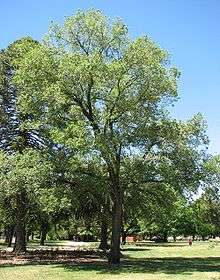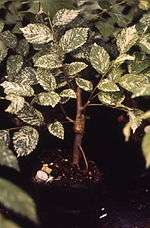''Ulmus minor'' 'Argenteo-Variegata'
| Ulmus minor | |
|---|---|
 'Argenteo-Variegata', Benalla Botanic Garden, Australia | |
| Cultivar | 'Argenteo-Variegata' |
| Origin | Europe |
The Field Elm cultivar Ulmus minor 'Argenteo-Variegata' or simply 'Variegata', known in Australasia and North America as Silver Elm [1][2] or Tartan Elm,[3] is said to have been cultivated in France from 1772. Green noted that variegated forms of Field Elm "arise frequently, and several clones may have been known under this name".[4] Dumont de Courset (1802) listed an U. campestris var. glabra variegata,[5] Loudon (1838) an U. nitens var. variegata, and Wesmael (1863) an U. campestris var. nuda microphylla variegata.[6][7]
'Variegata' is not to be confused with the variegated English Elm cultivar, U. minor 'Atinia Variegata', which has the broader, almost orbicular leaves of the type.
Description

The tree's foliage is randomly blotched and speckled with creamy white, the colour of the leaves on the same tree ranging from almost completely cream to totally green.[8][9]
Etymology
As the blotching and margination of the foliage may appear more silver than cream, the cultivar is sometimes listed as U. minor 'Argenteo-Variegata'.[10]
Pests and diseases
The cultivar is as susceptible to Dutch elm disease as the species.
Cultivation

Henry cited Loudon's report that 'Variegata' was cultivated in Chiswick in the early 19th century.[11] The tree remains in commercial cultivation in Europe, and is commonly cultivated in Australasia and North America, where a number of mature specimens survive (see under Accessions).
Notable trees
A notable specimen of Variegated Field Elm grew at Leek Wootton, Warwickshire.[12] In the Netherlands, one tree, known as the Rococo Iep (:Elm) grows at Houten, next to the old church. In Australia, several trees planted in 1897 stand in Geelong Botanic Gardens, Victoria.[13] 'Atinia Variegata' is also found among the elms lining the Avenue of Honour at Ballarat, while approximately 50 trees grow at The Nook, Sunbury. There are two mature trees in the Royal Tasmanian Botanical Gardens, Hobart.[14] A specimen in Portland, Oregon, has been designated a 'Heritage Tree'.[15]
Synonymy
- Ulmus folio glabro, eleganter variegato: Miller, The Gardeners Dictionary ed. 2. 1735, Ulmus no. 7.
- ?Ulmus campestris foliis argenteis: Baudriller, (Angers, France), Catalogue 43, p. 116, 1880.
- Ulmus campestris foliis variegatis: Loddiges, (Hackney, London), Catalogue 1820, p. 35, and by Loudon in Arboretum et Fruticetum Britannicum, 3: 1395, 1838.
- Ulmus campestris punctata: Simon-Louis Nurseries, (Metz, France), Catalogue, 1886–87, p. 60.
- Ulmus campestris var. suberosa variegata Hort.: Hartwig & Rümpler, Illustrirtes Gehölzbuch 581, 1875.
Accessions
North America
- Morton Arboretum acc. nos. 450-48, 588-54
Europe
- Dubrava Arboretum, Lithuania. As U. carpinifolia 'Variegata'. No details available.
- Grange Farm Arboretum , Sutton St. James, Spalding, Lincs., UK. Acc. no. 1083.
- Hortus Botanicus Nationalis, Salaspils, Latvia acc. no. 18143 (acknowledged as possibly U. minor 'Albo-dentata').
Australasia
- Benalla Botanic Gardens, Victoria, Australia. Accession details not known.
- Eastwoodhill Arboretum , Gisborne, New Zealand, 22 trees, details not known.
- Geelong Botanic Gardens, Geelong, Victoria. Planted to commemorate the death of Queen Victoria of England.
- Royal Tasmanian Botanical Gardens, Hobart. Two trees on Playground Lawn.
Nurseries
North America
None known.
Europe
(Widely available)
Australasia
- ETT, Wandin East, Victoria, Australia
- Fleming's Nursery , Monbulk, Victoria, Australia (as 'Silver Elm').
- Metro Trees, Fairfield, Victoria, Australia
- Mount William, Lancefield, Victoria, Australia
References
- ↑ treelogic.com.au/facts/ulmus-minor-variegata-silver-elm/
- ↑ flemings.com.au/ornamental_details.asp?CULT_ID=MINOR
- ↑ plantthis.co.nz/plant-information.asp?gardener=26019&tabview=photos&plantSpot=
- ↑ Green, Peter Shaw (1964). "Registration of cultivar names in Ulmus". Arnoldia. Arnold Arboretum, Harvard University. 24 (6–8): 41–80. Retrieved 16 February 2017.
- ↑ Dumont de Courset, George Louis Marie (1802). Le botaniste cultivateur. 3. p. 700.
- ↑ Bulletin de la Fédération des sociétés d'horticulture de Belgique 1862: 390, 1863
- ↑
- ↑ Hilliers' Manual of Trees & Shrubs. (1977). David & Charles, Newton Abbot, UK.
- ↑ Photographs of Ulmus minor 'Variegata', www.ogrodyprzydomowe.eu
- ↑ Photograph of foliage of U. minor 'Argenteovariegata', www.flower.onego.ru (photo 6)
- ↑ Elwes, H. J. & Henry, A. (1913). The Trees of Great Britain & Ireland. Vol. VII. p.1895
- ↑ Variegated elm at Leek Wootton, windowsonwarwickshire.org.uk
- ↑ Spencer, Roger, ed., Horticultural Flora of South-Eastern Australia, Vol. 2 (Sydney, 1995), p.114
- ↑ 'Variegated elms on Playground Lawn' (Royal Tasmanian Botanical Gardens, Hobart) by Natalie Tapson, flickr.com
- ↑ 'Heritage' Silver Elm in Portland, Oregon, portlandoregon.gov/parks/article/479576?
External links
- http://www.rhs.org.uk/RHSPlantFinder/Plantfinder2.asp?crit=ulmus&page=2&genus=Ulmus RHS Plant Finder, UK
- "Herbarium specimen - WAG.1853149". Botany catalogues. Naturalis Biodiversity Center. [right-hand specimen, distinct from variegated English Elm on left]